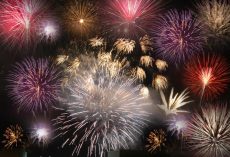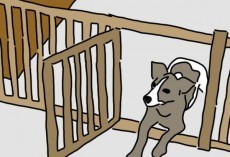Confidence killers abound in dogs. Other causes include emotional trauma, physical abuse or simply not getting enough social interaction. Shyness and fear are awkward traits that can sometimes lead to hostility and fear biting.
Dog owners can help their pets mature into confident, assured dogs by carefully but consistently introducing the pets to other people, other welcoming dogs and new surroundings outside the home. Daily walks on leash to different areas of the community are often the most practical way to do this.
If you are moving from the country or quiet suburbs to a more active and noisy urban location, pups and dogs should be gradually introduced such things as crowded sidewalks, noisy traffic and big diesel trucks. Start with an occasional trip into town long before the move.
Even if you don't plan a move in the future, you should still get pups and dogs acclimated to busy environments at an early age, since you will eventually be visiting such places occasionally. For very young pups without vaccinations, carry them so that they are not exposed to germs on the city sidewalks.
Paw-Rescue recommends that you set up a situation for learning new, positive responses:
If you have a more mature dog who is shy, help the dog gradually gain confidence. It's especially important to control any situation you introduce him to. Enlist the help of people you can trust to follow your instructions. Here's one approach:
Have your helper avoid eye contact with the dog, stay quiet and still, stand sideways to the dog, and keep at an ample distance from the dog. Do not force the dog to approach the person. Instead, let the dog initiate contact and approach when he feels ready.
The helper can crouch down or sit on the floor, maintaining the nonthreatening sideways stance, with eyes still averted. Give the helper some small tasty high-value treats, which may mean something really strong like liver cookies available at pet supply stores or bits of hot dog. Have the helper extend a hand in the direction of the dog and drop a treat. Eventually the dog will sniff around and slowly approach. Most likely, the dog will take the treat and retreat a bit to eat it. The helper should leave the hand extended, but not reach at the dog. Next, have the helper keep the treat in his extended hand.
The owner has a role to play during these exercises. Project a happy, relaxed body posture and tone of voice. Make it clear that you welcome the helper's presence. However, avoid too much chatter with your helper, and avoid distracting your dog. Ignore your dog if she tries to cling to you or beg for attention. Also make sure not to comfort the dog, verbally or physically, at times when the dog displays timidity or fear, since you do not want to reinforce these undesirable behaviors. You want your dog to get the clue that during these practice sessions, your helper is the only source for treats and positive interaction.
Eventually, the dog will show signs of budding confidence. Ideally, the dog will touch the helper's hand upon taking the treat. The helper can softly say, “Good dog”. When the dog seems somewhat secure, the helper can gently stroke the dog under the chin or on the neck or chest (be aware that shy and fearful dogs are often frightened when people attempt to touch their face or head). Eventually make eye contact. However, progress slowly to avoid the setback of a fear response.
It might take a few of these set-up encounters oft repeated for the dog to feel comfortable enough to approach at all. So be patient. The results will be worth it.
As the dog gains confidence, repeat these practice sessions in other rooms and then outside the home. Try this with other people of varying ages, sizes, and gender. Gradually expose the dog to new experiences and whenever he shows the slightest sign of relaxing or sociability. Reward your pet with effusive praise and affection.
Is your dog is shy around men? Many dogs are. If so, have a man prepare and set down your dog's meal. If the dog is fearful of someone in the family, are there valid reasons? Perhaps that person is doing something to invoke fear, even if the person is unaware of it. Perhaps the person speaks in a booming voice, makes a lot of noise or sudden movements, or tends to invade the personal space of others; in such cases, the person should try to tone down his or her behavior.
If it seems the dog's fear relates to the size or gender or physical traits of the person, work daily to desensitize the dog to the person, counter-conditioning to replace fear with friendliness. The dog will eventually learn to associate POSITIVE traits with men/big people/people in wheelchairs etc.
Here's one technique for building a bond between the dog and a person he fears in the household: let that person be the one to feed, walk and eventually play with the dog. The objective is to have the dog realize that good things happen with this person, that he must depend on this person for interaction, and that this formerly scary being can be trusted and will not hurt him.
There are many techniques. Keep working and results will show.
To learn more about this, check out Paw-Rescue.










